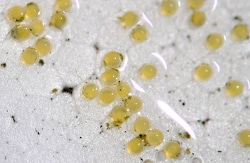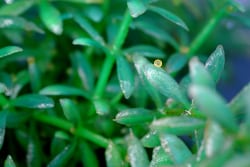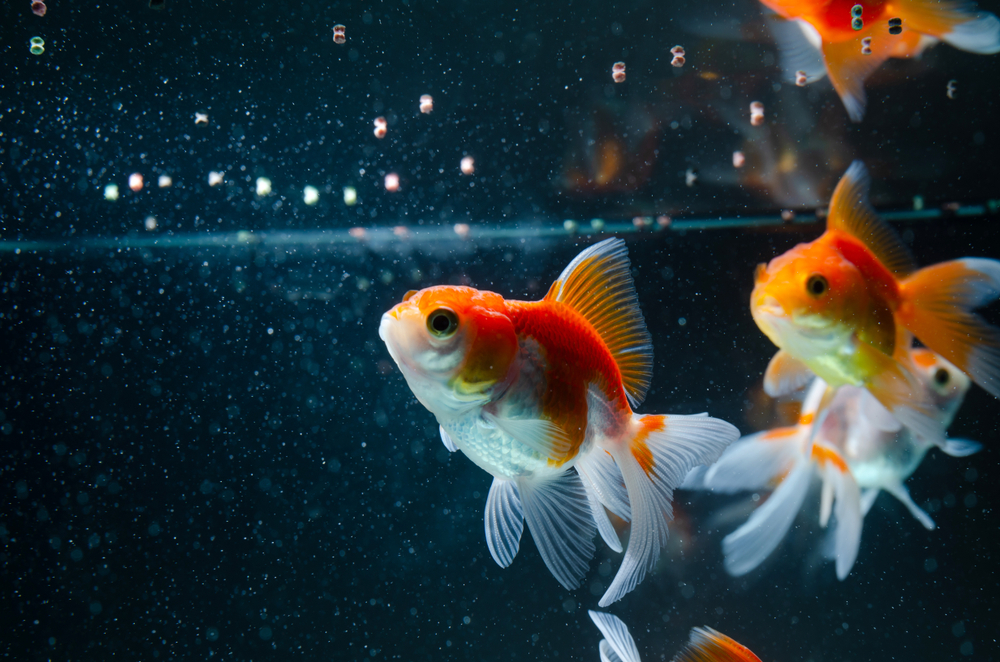Do goldfish lay eggs? Yes, they do! And female goldfish don’t just lay one or two goldfish eggs at a time… It’s one of our favorite goldfish facts that a female goldfish can lay several thousand goldfish eggs in one spawning!
Key Takeaways
- Yes, goldfish lay eggs, and a female can lay several thousand eggs in one spawning.
- Goldfish eggs are small, round, sticky, and translucent, with a dark spot in the middle indicating developing eyes.
- The eggs are typically laid on plants, decorations, or other fixed surfaces.
- Goldfish can lay eggs multiple times a year, especially if the water temperature is increased.
- Eggs take about 4-7 days to hatch, depending on the water temperature.
- If you want the eggs to hatch, remove them from the main tank as goldfish tend to eat their own eggs.
- Goldfish can lay eggs without a male, but the eggs won’t develop into fry unless fertilized.
What do goldfish eggs look like?
You won’t be surprised to hear that goldfish eggs don’t look like bird eggs! Goldfish eggs actually look like small round “bubbles”. They’re clear or light yellow in color, with a small dark spot in the middle of the egg.

Goldfish eggs are extremely sticky. If your goldfish lay eggs then you’ll probably find them attached to a leaf or piece of plant.

If you’re deliberately trying to breed your goldfish then we recommend using a spawning mop. This mop is specially designed to catch the goldfish eggs, which will help you find them and keep them safe. Adult goldfish are notorious for eating their newly hatched eggs quickly, so allowing the eggs to be laid in a special tank or removing the adults is the safest option to allow the eggs to hatch.
Female goldfish can lay up to 1000 eggs at one time and multiple times a week if the water temperatures are just right.
The eggs will become more see-through over a couple of days, assuming they are fertile. If they are not fertile then they will turn white.
After two or three days, tiny black spots will show in the fertilized eggs, these spots are the developing eyes of the fry (baby goldfish)!
The eggs can hatch in as little as four days if the water temperature is kept at 70-75F, if the water is warmer or colder then hatching can take up to seven days or could create health problems for the developing fry.
Scum can grow on the eggs very easily so it’s important to keep the water well aerated or add a water cleanser to prevent any fungus or scum buildup. If the fungus does build up on the eggs, then it can prevent them from hatching. Methylene Blue is a common water additive that prevents fungus growth and special fungus treatments are available.
How often do goldfish lay eggs?
This depends on how the water temperature fluctuates. If you change the water temperature in just the right way, it’s possible for goldfish to lay eggs two or three times per year.
To replicate this in an aquarium, the tank will need to be slowly warmed over the course of a few days to signal to the fish that it is time to spawn. Starting the temperature of the aquarium at 50F and warming it up to 70F is the ideal temperature range.
The female fish will send out pheromones to signal the males to start producing milt and then after some dancing and chasing the female will lay the eggs and the males will coat them in their milt.
Goldfish will lay their eggs on a fixed object in the tank or pond. Due to the sticky coating on the eggs, they will adhere to a fixed surface.
How to tell when your goldfish is going to lay eggs
The fact that goldfish lay eggs means that goldfish do not get pregnant. They will however look a bit like they’re pregnant. Their bellies will swell around the time they are ready to lay eggs.
Female and male goldfish will start to show subtle physical signs that the female is ready to release eggs and milt.
Female goldfish are naturally rounder than males, but when they are ready to release eggs, they grow a little bit rounder. This is best seen by looking down on the fish to see a change in the size of the belly.
Male goldfish will have small white bumps, called spawning tubercles, appear on their heads, gill covers, and pectoral fins. These bumps signify that spawning is about to occur between the male and female goldfish.
It is good to look at your fish prior to spawning to make it easier to see any physical changes in the fish in the tank or pond. The female will exhibit other behaviors when she is getting close to laying eggs. She will have changes in her activity levels and feeding levels.
Changes in activity levels
Slowing down or appearing slightly sluggish can be seen as a precursor to egg laying. During this time, she may also hide a little bit in parts of the pond or aquarium. She may even hang around a spawning mop that is in the tank or pond.
Changes in feeding behavior
They can start to eat a little less when they are about to spawn. They should not suddenly stop eating, this can be a sign of illness and not egg-laying.
Spawning behaviors
Goldfish will spawn when the weather warms up into spring if they are housed in an outdoor pond. If they are housed in a tank, then modifying the water temperatures will signal to the goldfish to start spawning.
Goldfish will not spawn when they are under one year old and are in their prime for spawning when they reach three years old.
Once the female goldfish is ready to release her eggs, she will release hormones into the water to signal the males that it is time. The males will then start to exhibit spawning behaviors. These behaviors are when males will start pushing into the belly of the female fish and chasing her around the tank.
This pushing behavior will cause the female to release her eggs so the male can lay his milt on the eggs to fertilize them. If the female is extremely full of eggs and she is picked up, then it is possible that the eggs can fall out of her.
Can A Goldfish Lay Eggs Without Male?
Yes, female goldfish can lay eggs without the presence of a male through a process called “spawning.” Goldfish are known to be egg-laying fish, and under certain conditions, females can release eggs even without the fertilization by a male. However, for the eggs to develop into viable fry (baby fish), they need to be fertilized by male goldfish during the spawning process.
In the absence of a male, the unfertilized eggs typically won’t hatch. If you’re not planning to breed goldfish, it’s advisable to provide an environment that discourages spawning behaviors, as the presence of eggs can lead to potential health issues for the female goldfish. This includes ensuring that the water conditions are stable, and there are no factors that might trigger breeding behaviors in the absence of a suitable mate.
How long does it take goldfish eggs to hatch?
Goldfish eggs can take up to seven days to hatch, however, it is most commonly between four to seven days.
How long it takes goldfish eggs to hatch depends on the temperature and quality of the water. If the water is too cold, then it can take the eggs longer to hatch. If the water is too hot, then the eggs may never hatch.
When eggs are laid, they should be removed from the main tank as soon as they are noticed. Eggs left in the main tank for too long are at risk of being eaten by the other fish.
What should I do with the eggs that I find in my tank?
If you don’t want to keep the eggs and aren’t interested in them hatching, then you can leave them in the tank and the adult goldfish will eat them. Goldfish will quickly eat the eggs once they are laid. You will want to check that all the eggs are removed, whether by removing or allowing them to be eaten, to ensure that they don’t cause any water contamination.
Unfortunately, goldfish will eat their own eggs, so if you do want the baby goldfish to have a chance of hatching, you can’t just leave the eggs in the main tank. You must remove the eggs from the tank or pond as soon as possible.
Once the eggs are moved into their own tank the water should be kept at a temperature range of 70F-75F degrees, this temperature range means you can see eggs hatching in as little as four days. The ideal depth of the water for eggs to hatch and the subsequent fry to develop appropriately is six to seven inches.
If you do want the eggs to hatch then you will hopefully have prepared a small fry tank before the eggs are even laid. You can find out more about this in our article on goldfish breeding.
If you do have a fry tank ready then you can move the eggs – or even the whole plant or spawning mop that the eggs are attached to – and put them into the small tank. If not, you’ll have to quickly find a temporary container!
Whatever container you use, you should ensure that the fry tank is at a similar temperature to the main tank. Use an aquarium heater to slowly raise the temperature of the water if necessary.
Finally, you don’t necessarily have to transfer all of the eggs to the fry tank. Lighter-colored eggs have a much greater chance of hatching, so you can dispose of dark eggs and only transfer the lighter ones.
Egg development
In the egg tank, you need to have proper aeration to prevent scum buildup on the eggs. Scum buildup can cause disease to move across the eggs and kill them off.
After two days, the eggs in the tank will change color slightly. You will be able to see eye development after two days in the healthy eggs and two days after that the baby fish should emerge.
A large amount of fry will be born, but a large portion will also die off due to inadequate food, disease, and poor conditions. Once the fry starts hatching, you will need to verify the water surface is free from scum or any sort of buildup. The fry will need to get to the surface to take a breath of air which allows their air sacs to inflate. After a day or two the fry will become free swimming and want to eat.
Goldfish eggs in ponds
Goldfish will lay their eggs in a shallower part of the pond and near the edges. You will want to place spawning mops or plants near the edge, so the eggs are easier to spot and remove.
Goldfish will spawn in the springtime and you will want to check frequently for any eggs that are laid that you want to keep.
Once the eggs are found, you should gently rinse them in fresh water and move them to their own aquarium to hatch. If you aren’t planning on keeping the eggs, then you can leave them in the main pond and allow the other fish to eat them. Goldfish eggs look the same in the pond as they would in an aquarium.
The Role of Diet in Goldfish Reproduction

A well-balanced diet is crucial for the reproductive health of goldfish. High-quality pellet or flake food supplemented with live or frozen foods can provide the essential nutrients needed for successful breeding. Ensuring that both male and female goldfish are in optimal health contributes to the likelihood of a successful breeding event.
Conclusion
In conclusion, goldfish do lay eggs as part of their natural reproductive process. Understanding the signs of breeding behavior, preparing a suitable habitat, and dispelling common myths can enhance your experience as a goldfish enthusiast. Remember that responsible breeding practices contribute to the well-being of these captivating aquatic creatures.
FAQs
- How do I know if my goldfish is laying eggs?
- You can observe certain behaviors indicating that your goldfish is laying eggs. Look for the female scattering small, adhesive eggs on surfaces, often followed by the male fertilizing them.
- Do goldfish lay eggs or give birth?
- Goldfish lay eggs. They are egg-laying species, and the process involves the female releasing eggs and the male fertilizing them externally.
- What do goldfish eggs look like?
- Goldfish eggs are tiny, translucent, and adhesive. They are often laid in clusters and can be attached to plants, decorations, or the substrate in the aquarium. The eggs may appear gelatinous and spherical.
Why do my gold fish eye go blind
I have a goldfish swimming upside down, when I feed them it eats, after that it stay back upside down? What should I do? Thanks
Hi Loke,
sounds like your goldfish has swim bladder, we have a guide on it here which may help you: swim bladder in goldfish
hope this helps
Thank you very interesting,,I have feeder, goldfish, they are big and beautiful, will they lay eggs
Hi Denice,
If the conditions are right and they decide to breed, they will lay eggs that will hatch into baby goldfish, but the parents will eat them unless they are separated.
I’ve aranda fish and thry have layed eggs they are milky white I don’t need more fish as I’ve only two tanks
I have a breeding tank, in the tank are the pregnant female and my breeding male and a chaser male. They have several times began the ritual chasing and body pushing but then it’s like they go off the boil so to speak, I don’t know if my female could be egg bound.
Please let me know if this is ok or if there could be an issue, many thanks.
Regards.